Donegal Castle's Celtic History
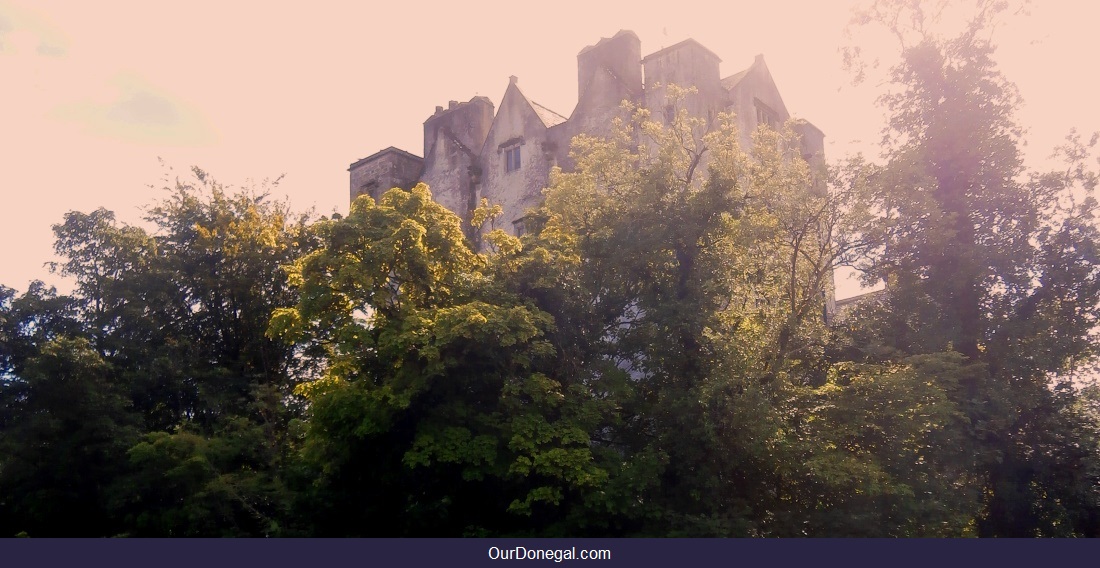 Donegal Castle in Donegal Town
Donegal Castle in Donegal TownDiscover Donegal Castle's 540 Years Of Dramatic Irish Celtic History
Former Stronghold Of Celtic Chieftains. Enemy Occupation. Re-Claimed. Burned. Restored... And More!
You'd hardly believe what this unique Celtic castle has been through in the 540 years, plus, of its dramatic existence.
Strategically situated on the meandering river Eske, the former Donegal stronghold of Celtic Chieftains endured enemy occupation, was re-claimed... and then burned.
As if that wasn't enough, the castle fell to the enemy again. This time it was subjected to a renovation with a difference.
Here's how it all happened...
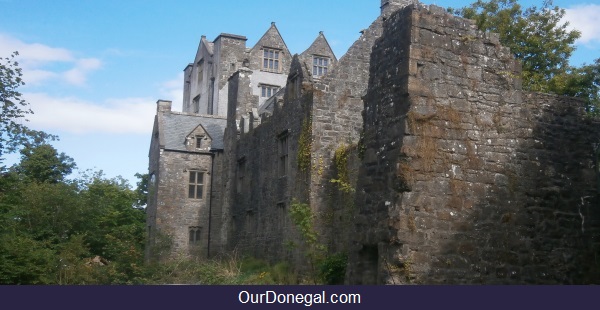 O'Donnell's Celtic Castle showing watchtower ruins in foreground
O'Donnell's Celtic Castle showing watchtower ruins in foregroundDonegal Castle's Early Years
Donegal Castle was originally built by Chieftain Red Hugh O'Donnell the First in 1474. The powerful Celtic Chieftain of Donegal also facilitated the construction of nearby Donegal Abbey, completed the same year.
A Chieftains' Stronghold
This largest, most strongly fortified of all Ireland's Gaelic Celtic castles, was built in the form of a towering keep. The castle was the main residence of O'Donnell Chieftains and their families for over a century and a quarter.
O'Donnell Castle Donegal's original appearance, strategic locationInvading Forces
In 1601 the castle was temporarily occupied by invading forces under the powerful English Crown. Those same forces had also invaded, and then demolished the Donegal friary.
Red Hugh O'Donnell II
Red Hugh O'Donnell the Second was the Chieftain of Tirconnell at the time. He was the great, great grandson of Red Hugh O'Donnell the First.
Amid a lengthy siege, the heroic young Celtic Chieftain succeeded in re-claiming his castle.
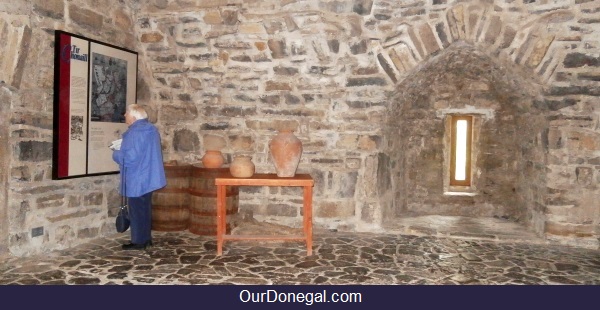 Original 540 year old floor and walls
Original 540 year old floor and wallsThe Battle Of Kinsale, The Chieftain's Death
Meanwhile, Spanish military support had arrived at the far end of Ireland, in County Cork.
On hearing of the Spaniards' arrival, Red Hugh withdrew his troops from Donegal. He then marched the long journey south to Cork with his army.
The Chieftain joined forces with the Spanish against the English Crown in the historic Battle of Kinsale.
Red Hugh O'Donnell the Second died and was buried in Spain in 1602, while raising further military support for the cause of Irish liberty.
The Castle is Burned
Prior to his departure, the O'Donnell Chieftain dramatically burned his castle to make it useless should the enemy capture it again.
Sure enough, just a few years later what remained of the castle had once again fallen to the English Crown, who by then had full control of Ireland...
A Captain Rewarded
The once beautiful Gaelic Celtic castle of the O'Donnells, along with their extensive lands, was subsequently granted to an English military Captain in 1610.
Captain Basil Brooke, later Knighted, had played a significant role in the overthrow of Gaelic Ireland.
The Castle's Unique Renovation
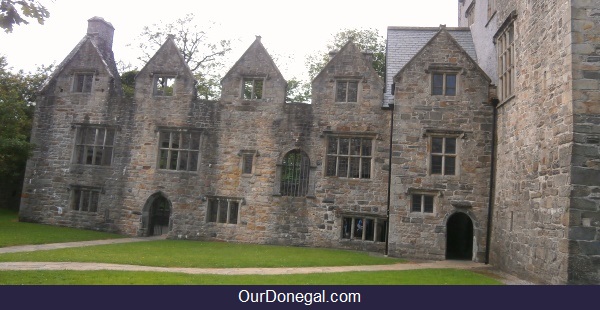 Brooke's Jacobean extension to the Celtic castle
Brooke's Jacobean extension to the Celtic castleThe English captain built himself a manor-house, as an extension onto the south-western side of the O'Donnell castle.
The captain also renovated the castle itself.
A Jacobean Twist
The new manor-house, along with the modifications to the castle, added a unique jacobean-style twist to the original Celtic look of the castle.
Donegal Castle was, at that time, already almost 140 years old.
The Rewards Continue
Donegal Abbey
In addition to the O'Donnell castle and lands, Sir Basil Brooke received the ruined shell, and accompanying lands, of the Donegal friary.
The Knighted Captain used the scattered stones from the sacred ruins of the abbey to refurbish Donegal Castle.
What's 'Jacobean'?
The Jacobean style of architecture is associated with English Monarch, King James I. He ruled from 1603 to 1625.
The style contained elements of Dutch and German influence.
Customs and Excise 'Rights'
Sir Basil Brooke was also given English Crown-imposed Customs
and Excise 'rights' over the River Eske from the castle to Donegal Bay.
The river Eske was an abundant source of
fish.
Donegal Castle Abandoned
The O'Donnell Castle Donegal Town was occupied by Sir Basil Brooke until his death in 1633.
After his death, the estate passed to his son Sir Henry Vaughan Brooke, Member of the English Parliament governing Donegal County. Vaughan Brooke was in possession of further estates in neighboring County Fermanagh.
After several more transfers the neglected castle was eventually abandoned.
A National Treasure
In 1898, the dilapidated castle was placed under the guardianship of the Office of Public Works. Approximately 100 years later, that office conducted restoration works on it.
A favorite tourist attraction, Donegal Castle is now open to the public.
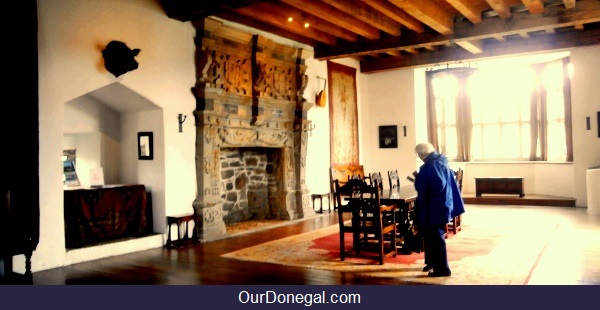 Restored castle banquet hall
Restored castle banquet hallRestored
The damaged parts of the original Celtic castle have been restored, as have the Jacobean features added by Sir Basil Brooke.
However, the three-storey, triple-entranced Jacobean manor-house extension still remains largely a dramatic empty shell.
The exception in the manor-house is a small section which was roofed, providing access to the castle.
A Unique Attraction
Could this be the only Gaelic Celtic castle in the world with a Jacobean refurbishment, complete with Jacobean manor-house side-extension?
If you know of anything like it anywhere, do let us know, we'd love to hear about it.
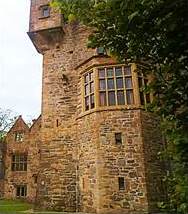
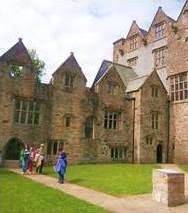
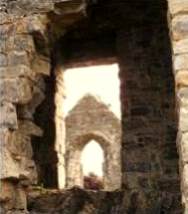
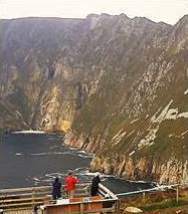

New! Facebook Comments